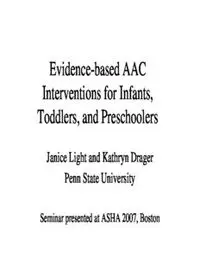
Evidence-based AAC Interventions for Infants, Toddlers, and Preschoolers PDF
Preview Evidence-based AAC Interventions for Infants, Toddlers, and Preschoolers
Evidence-based AAC Interventions for Infants, Toddlers, and Preschoolers Janice Light and Kathryn Drager Penn State University Seminar presented at ASHA 2007, Boston The Penn State Team • Jen May • Emily Angert • Holly May • Julia Birmingham • Ashley Maurer • Jacky Cammiso • Rebecca Page • Jen Curran • Elizabeth Panek • Elizabeth Hayes • Sarah Pendergast • Melissa Ihrig • Kate Shapiro • Lauren Karg • Nicole Sherman • Line Kristiansen • Kristin Stoltzfus • Wendy Lewis • Melissa Witte • Ashley Marzzacco The challenge • How do we provide access to the magic and the power of language and communication for young children with complex communication needs who require AAC? What did I learn watching my kids learn language? • Young children – Start learning communication & language at birth – Learn language during daily activities in their environment, especially play – Learn language in the context of social interactions with familiar partners – Communicate not just to express needs and wants, but also to build social closeness and share information • Social interactions are prime times to build language – Depend on context to learn language • “First words” are context-bound What did I learn watching my kids learn language? • Young children – Receive scaffolding support from their parents to help them learn language • Parents provide opportunities for communication & language learning • Parents adjust language input to children’s understanding • Parents respond to children’s communicative attempts – Receive 100,000s of models of language use • Parents say words to children before they “know” the words – Learn language rapidly – Have fun learning language Principles to guide AAC intervention with young children • Start as early as possible – Intervene with infants, toddlers, preschoolers who are at risk • Intervene in natural environment during daily activities – Maximize functionality, familiarity, meaningfulness • Focus on sustained social interactions with familiar partners – NOT just expressing needs and wants, – but also building social closeness & sharing information in sustained social interactions Principles to guide AAC intervention with young children • Provide contextual support to help children learn language – Use context to support comprehension & expression – Infuse familiar experiences /contexts into AAC systems • Show parents how to provide appropriate scaffolding support – Provide frequent opportunities for communication – Provide appropriate language input – Respond to child’s communicative attempts Principles to guide AAC intervention with young children • Provide models of AAC & speech – Use AAC & speech when talking to child • Sign & speech • Aided AAC & speech – Expand on child’s messages using AAC & speech • Ensure that AAC systems are dynamic – Support language learning – Regularly introduce/ add new concepts for child – Model their use Principles to guide AAC intervention with young children • Ensure that intervention is FUN!! – Integrate communication & play – Enhance motivation of child and family – Ensure that AAC systems are appealing and fun! – Ensure that AAC systems are easy to learn and use! Goals of the presentation • Share the results of a research study that developed, implemented, & evaluated the effects of AAC interventions on the language and communication skills of young children with complex communication needs – Multiple baseline across participants • Share case examples to illustrate AAC intervention and outcomes
